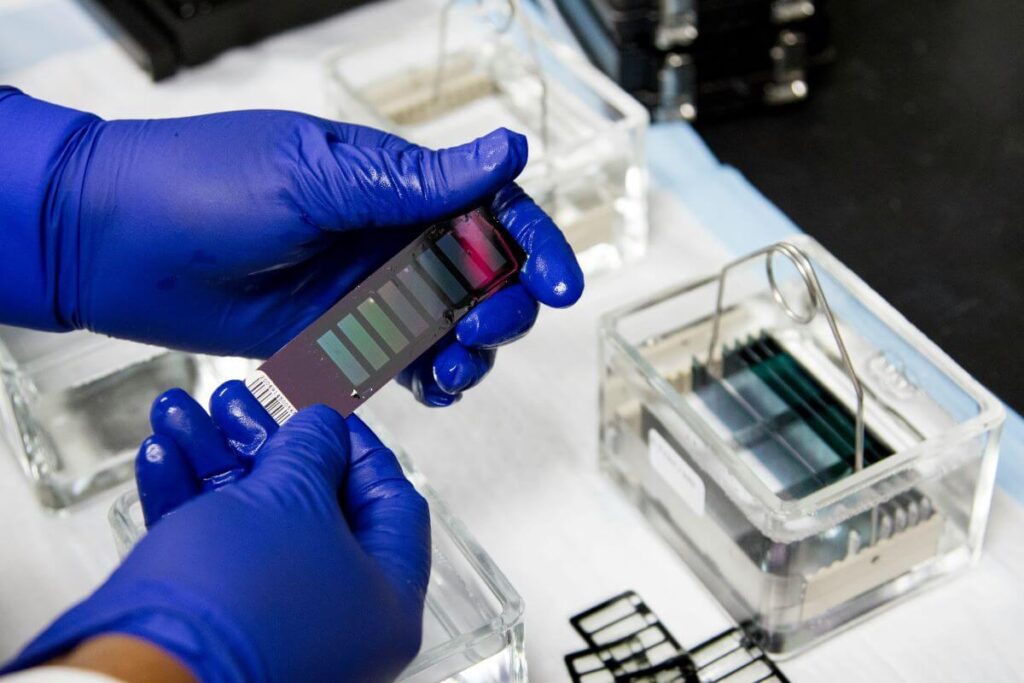First in Human clinical trials play a crucial role in ushering investigational new drugs or interventions into clinical practice. First in Human trials, follow preclinical testing, using in vitro and in vivo experimental models to ensure the safety of participants. The process involves four phases, with drug candidates typically gaining approval after the third phase if proven safe and effective.
Conducting First-in-Human clinical trials presents notable challenges due to their role as the initial Phase 1 studies, emphasising the importance of careful design and prioritising participant safety. This article will explain the key considerations for CROs when it comes to the planning and implementation of First in Human trials.
What Are First in Human Clinical Trials?
First in human clinical trials mark the initial administration of a drug to humans following testing using, in vitro and in vivo preclinical experimental models. Typically, involving healthy volunteers, these trials may include patients, particularly when investigating high-risk drug candidates such as certain antitumor drugs for individuals who cannot readily benefit from existing therapies.
Despite meticulous planning and preclinical data collection, inherent risks and challenges are associated with first-in-human clinical trials. The success and safety of these trials hinge on the expertise of the medical and scientific staff leading them. A multidisciplinary team typically conducts First in Human trials, comprising professionals such as a clinical pharmacologist, safety physician, formulation scientist, clinical development scientist, clinical operation specialist, toxicologist, and regulatory affairs specialist.
Phase 1 trials, the first stage in First in Human trials, involves a small group of individuals, which can range from 20 to 80 people, to assess the safety, adverse effects, and appropriate dosage of the investigational drug. Early phase 1 trials furnish data on the drug’s safety in humans and insights into its mechanism of action. Advanced phase 1 studies provide additional information on the drug candidate’s pharmacological effects, metabolism, adverse effects linked to dose escalation, and potentially early effectiveness data.
In Vitro and In Vivo
“In vitro” is Latin for “within the glass,” and studies conducted in vitro are carried out outside a living organism. This could involve experiments conducted in a test tube or within a laboratory setting. Researchers may use this method to test the effects of a drug on cell samples, or to further research diseases.
“In vivo” is Latin for “within the living,” and is to do with any studies conducted within living organisms. An example would be studies performed on cattle, or humans.
Both methods are used in the pursuit of advancing knowledge in the area being studied, for example, rare diseases. Typically, studies tend to be conducted In Vitro first, so within a lab or test tube environment, before moving on to In Vivo when it is deemed safe enough to do so.
Challenges That First in Human Trials Present
As these First in Human Trials are the initial administration of an investigational drug in humans, they inherently pose challenges, particularly around ensuring the safety of participants. Furthermore, the landscape of clinical trials is evolving with increasingly intricate designs, further complicating the already intricate nature of First in Human clinical trial design. Additionally, these trials typically involve a small sample size, limiting observations to effects that occur with higher frequency.
Several factors, such as the presence or absence of biomarkers, the appropriateness of selected preclinical models, and the demographic characteristics of study participants, may influence the design of first-in-human clinical trials. Nevertheless, regardless of the details of the study design, prioritising the safety of participants should always be the paramount concern in conducting a first-in-human trial.
Requirements of a First in Human Clinical Trial
A First in Human clinical trial must meet specific requirements, including:
Data on the Quality of the Investigated Drug
Thorough evaluation of the pharmaceutical formulation’s quality is essential before commencing the clinical trial.
This evaluation encompasses:
- Data on the strength and potency of the investigated drug.
- Characterisation of its heterogeneity, impurities, and degradation.
- Findings on its suitability to deliver the intended dose.
Comprehensive Preclinical In Vivo Data:
Before initiating human studies, a preclinical programme of in vivo studies in animal models is crucial to assess the safety and efficacy of the drug candidate. These studies typically include toxicological, pharmacokinetic, and pharmacodynamic data. The selection of the animal species and models are a critical consideration, guided by similarities to the expected human biological response to the drug of interest.
Supplemental In Vitro Models
In vitro models, including human cells and tissues, may provide additional insights into a drug’s potential effects on humans. However, challenges exist in extrapolating preclinical data to humans, and there is a risk that the animal model may not encompass all the characteristics of a medical condition affecting humans.
Aspects of First in Human Clinical Trials
Critical aspects of First in Human trials encompass the careful consideration of the starting dose, dose acceleration schedule, study duration, and the administration route of the study drug.
Study Population
One of the biggest decisions that needs to be made regarding first in human trials is what kind of participants the drug will be tested on. The decision to use healthy volunteers or patients in a first in human clinical trial involves careful consideration of multiple factors.
The risks associated with enrolling healthy volunteers versus patients must be thoroughly evaluated, considerations such as:
- Toxicities
- Lifestyle conditions
- Potential benefits to patients
- How the drug might affect the participant (Pharmacodynamic)
- How different patients may affect the drug (Pharmacokinetic)
Studies involving healthy volunteers should establish inclusion/exclusion criteria mandating normal vital signs, electrocardiograms (ECGs), and clinical lab assessments.
Furthermore, study protocols should explicitly outline the nature of these assessments, including their timing and anticipated changes. Protocols must also clearly define the duration of subject follow-up and articulate how subjects with abnormal findings will be monitored beyond the study period. Safety monitoring should extend beyond just assessing pharmacokinetic data; it should also consider pharmacodynamic effects.
Starting Dose Selection
Protocols should describe and provide explanations for the anticipated initial drug dosage, the maximum level of drug exposure allowed, and the sequential steps for dose escalation.
The selection of the starting dose involves balancing the need to minimise toxicity risk to the participant, while ensuring the induction of pharmacologic activity in subsequent studies.
The U.S. Food and Drug Administration (FDA) recommends converting no observed adverse effect levels (NOAELs) from animal studies into human equivalent doses (HEDs) to determine the maximum starting dose.
A safety factor is then applied to derive the maximum recommended starting dose (MRSD) from the human equivalent doses of the most relevant species. While this approach is designed to establish the maximum suggested starting dose, lower starting doses may also be appropriate in certain first-in-human clinical trials. Protocols should outline the criteria guiding decision-making for adjusting dosage in response to clinical data gathered during the trial.
Dose Acceleration
Determining the dose range and acceleration schedule is crucial. Sequential dosing, with an observational period between administrations, aids in quickly identifying and responding to unexpected adverse effects. Data collected on the dose range informs the selection of doses for efficacy investigation in the later phases.
Study Duration
The duration of the study depends on the investigated drug and its anticipated effects on any participants.
Defining When to Stop
First-in-Human trials and dose escalation protocols are required to state the stopping rules clearly for individuals, dose escalation, and the overall study. These rules must explicitly indicate whether a stoppage is temporary for further evaluation or a definitive end to dosing for the entire study. Additionally, protocols involving healthy volunteers should incorporate precautions in the event of the following:
Serious Adverse Reaction in One Subject
Defined measures and actions that need to be taken in the case of a serious adverse reaction in a single subject.
Severe Non-Serious Adverse Reactions in Two Subjects in the Same Cohort
Established guidelines for addressing severe non-serious adverse reactions occurring in two subjects within the same cohort.
The protocols should clearly say whether such occurrences prompt a temporary halt for further evaluation or result in a final cessation of dosing for the study. These well-defined stopping rules and precautionary measures are critical components of protocols, ensuring a proactive and systematic approach to participant safety and the overall integrity of the clinical trial.
The Clinical Trial Site
Selecting suitable clinical facilities led by investigators and staff possessing the requisite training and expertise in early phase clinical trials is crucial. It is important for First in Human clinical trials to occur under controlled conditions, with vigilant supervision of trial participants both during and after dosing.
Sites should be equipped with emergency supplies, and the staff must be well-prepared to handle medical emergencies. Although First in Human studies are ideally conducted at a single site, if multiple sites are necessary for enrolment, protocols should outline measures to mitigate risks and unwanted variations in data that can be associated with using multiple sites.
Risk Mitigation in First in Human Clinical Trials
The study monitoring and risk mitigation strategy for First in Human clinical trials must be pre-established and underpinned by a well-defined rationale.
The European Medicines Agency (EMA) has established guidelines which can be used by CRO’s to help identify any potential risks in a first in human trial, and how they can be mitigated. The guidelines state that the safety of participants should always be the biggest priority; that it is the responsibility of the sponsors to define any uncertainties within the trial, and any potential risks they may cause.
However, CROs should also exhibit adaptability and responsiveness to any emerging data from the clinical trial. This means that clear criteria for managing adverse effects and guidelines for deciding whether to halt the trial or proceed with dose acceleration need to be established. This comprehensive approach ensures a robust framework for participant safety, data collection, and thorough evaluation of the investigational drug’s effects.
Conclusion
First in Human clinical trials are a vital step needed in the process of creating new life-saving drugs, as well as discovering more information about how certain drugs and diseases impact humans. First in Human trials do carry inherent risks, but with the proper protocols and processes in place, these risks can be mitigated or minimised.
While the benefit of successful first in human trials can potentially be massive, every clinical trial should prioritise the safety and well-being of its participants before anything else. To ensure this is the case, protocols must have detailed breakdowns of how adverse drug effects are monitored, responded to, and in a worse case scenario, when the trial is stopped altogether.
Navigate First in Human Trials with Confidence
At Simbec-Orion, we have almost 50 years of experience in First in Human clinical trials, and navigating the complexities that they present. Our team of clinical pharmacology experts focus on providing a professional experience, so that drugs can be investigated effectively, while at its core, remaining safe for any participants.
Get in touch with our team today to find out more about how expertise in First in Human trials can help you achieve success in your clinical studies.





